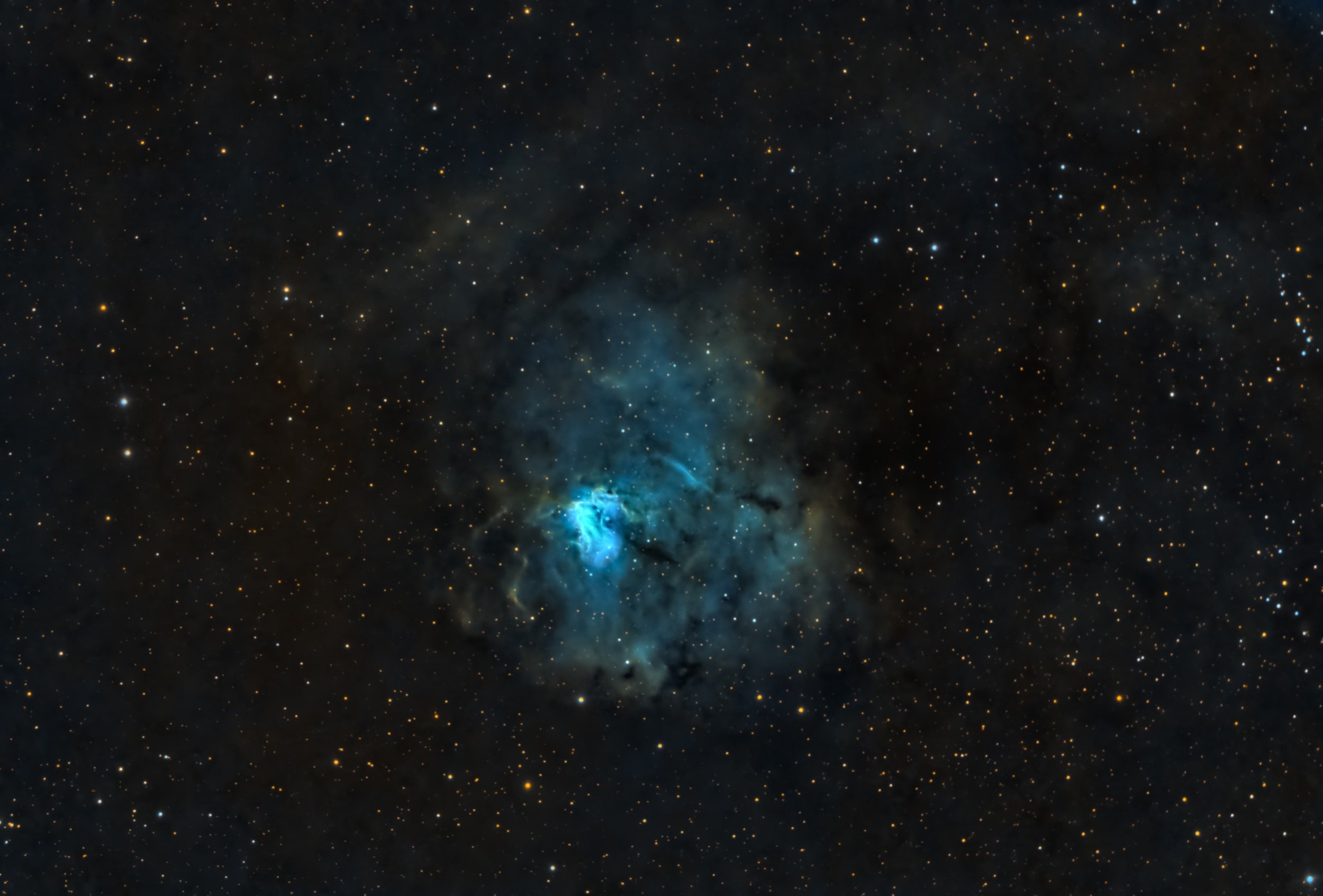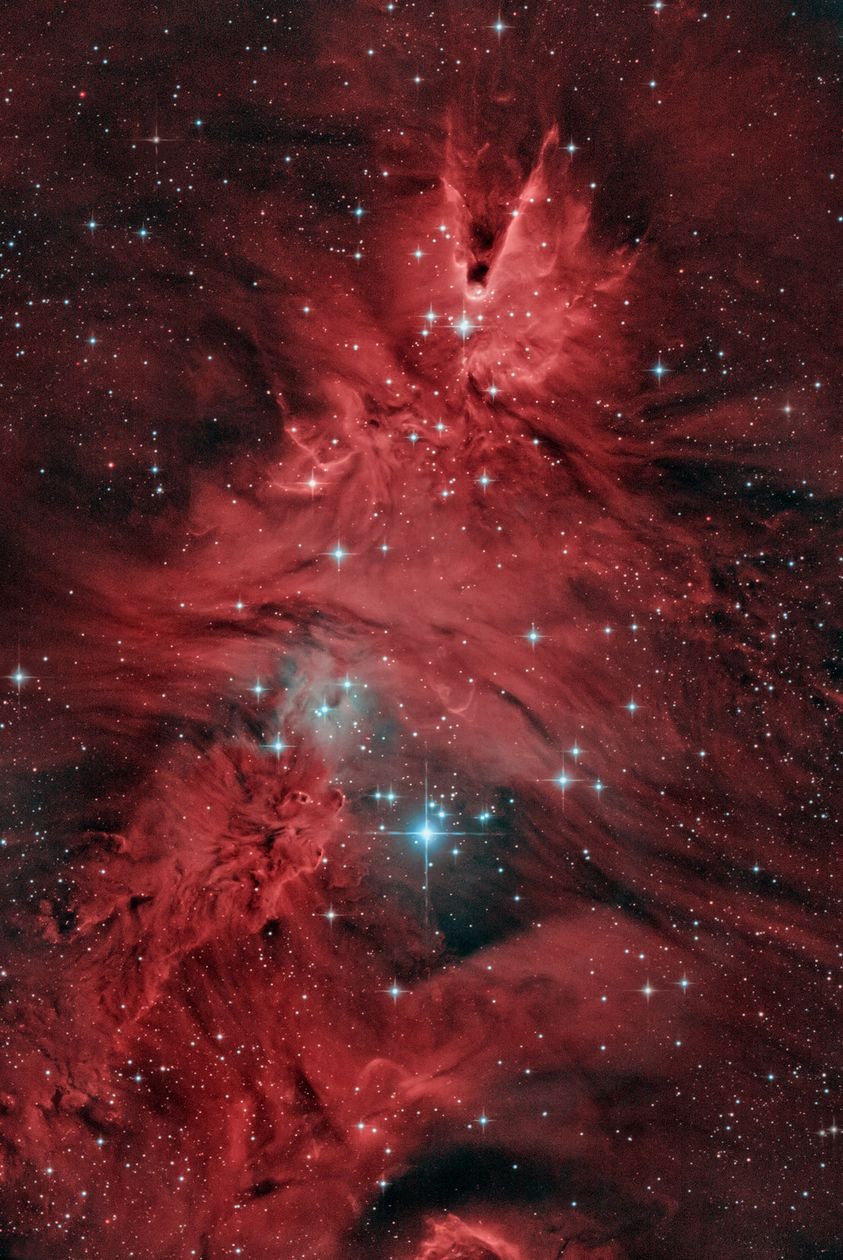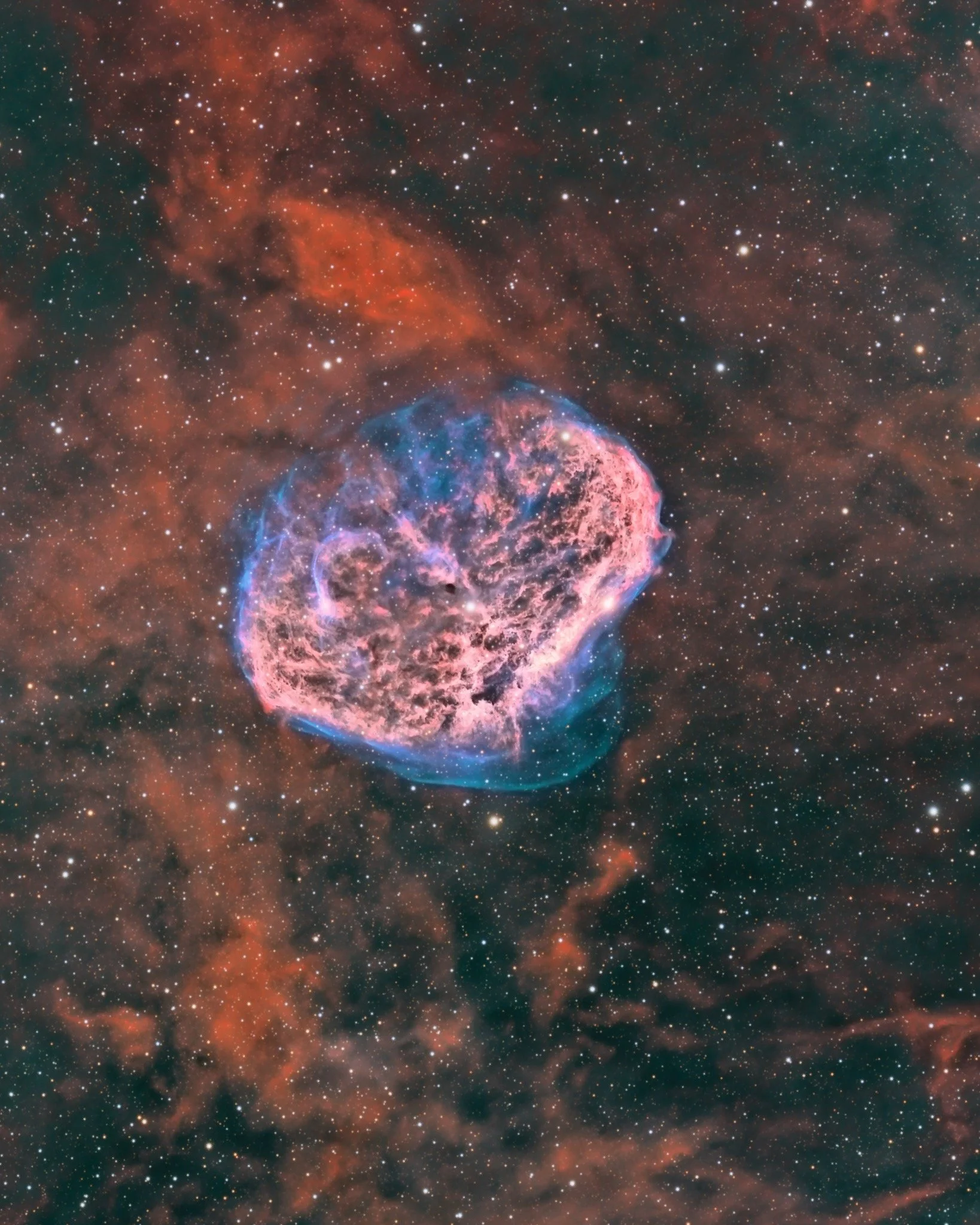
AAPOD2 Image Archives
Fossil Footprint Nebula in Hubble palette
Image Description and Details : NGC 1491 (also known as the Fossil Footprint, LBN 704 or Sh2-206) is a bright nebula discovered by William Herschel in 1790, in the constellation of Perseus. It is glowing deep red because the hydrogen gas in the nebula is energized by hot, massive stars embedded within. These stars emit copious amounts of ultraviolet (UV) light that causes the gas to glow.
Here is in Hubble palette rendition.
Konus 200/1000 @960mm, F4.8
Qhy168c @-5 °C
Sky-Watcher Eq6r Pro Mount
Optolong L_eXtreme 58x300" (gain 11, offset 60)
Optolong L_Ultimate 75x300" (gain 11, offset 60)
SvBony SII 7nm 172x300" (gain 11, offset 60)
SvBony UV/IR-cut 33x60" (gain 1, offset 35)
Kstars/ekos, APP, PixInsight, PS
Copyright: Massimo Di Fusco
NGC 2264 Christmas Tree Cluster & Cone Nebula
10 hour in HOO
100 x 3 min Ha + 100 x 3 min OIII
Telescope: TS Newton 10" f/4 CF, GPU 1x
Camera: ZWO ASI294MM Pro
Filters: Astronomik 6nm
Mount: iOptron CEM70-NUC
Software: PixInsight, Photoshop, Lightroom
Copyright: Andrei Gusan
Ariane V carrying James Webb Space Telescope
The historic launch of JWST took place on 25th December 2021. The visuals were sudden as we did not expect to come across the Ariane V rocket from West Bengal. Initially we thought it to be a comet (including Leonard for a moment) and confirmed the object sometime later. It was a "Dream come true" for us.
The first image shows Ariane V trailing past Sculptor Galaxy. The second image is a sequence captured over 15 minutes and the third image was its first visuals.
Exif: 2 seconds, f/2, ISO 500, 135mm, Stack of 40 images (Image 1), Stack of 10 images each (Image 2), Stack of 10 images (Image 3).
Gear: Nikon D5600, Samyang 135mm (on a tripod)
Processing: Sequator, Pixinsight, Adobe Camera Raw, Photoshop
Location: Sukna, West Bengal, India
Date: 25th December 2021
Copyright: Samit Saha & Soumyadeep Mukherjee
NGC1365 in Fornax
Image Description and Details :
First light of ATRIA observatory, one of the most beautiful galaxies from the Fornax NGC1365 and NGC1097 with a PlaneWave CDK17 installed at Deep Sky Chile. ATRIA team composed of 6 members: Olivier Désormières, Fabien T., Frédéric L .. David Néel, Julien Bourdette, and myself ;-) Arnaud PeelI try to keep as much detail as possible for a close-up view. I specifically process the center core of the galaxy to keep the colors and the detail at the maximum of the resolution of the acquisition FWHM< 1.6" .Processing: Arnaud PeelTotal exposure : 11h15Red 18subs@420s -15°C gain highGreen 20 subs@300s -15°C gain highBlue 20 subs@300s -15°C gain highLight 165subs@180s -15°C, gain high
Copyright: Arnaud PEEL
The Wizard Nebula
Image Description and Details :
Ngc 7380, nébuleuse du Sorcier.
version sho,
optique: 200/1000 SW
camera: Atik 460ex guidage: Asi 290 mini.
monture: eq6
integration: 20h
Copyright: Rémi Méré
vDB 24
Image Description and Details :
vdB 24 is a reflection nebula in the constellation of Perseus. It is illuminated by the luminous and variable star 'XY Per', which is the bright star just below the blue nebulosity near the center of the image. vdB 24 is embedded in a larger dark nebula called LDN 1442, which can be seen as the brownish gas
Telescope Astrosib 20" + camera FLI Kepler 4040 cmos
Total=36h50mn
CCDautopilot +Pixinsight
From E-eye my remote observatory in Spain
Copyright: Georges Chassaigne
THE CRESCENT
34hr 31min total exposure time
96x300” Ha
119x300” Oiii
150x60” R
66x60” G
74x60” B
40x Darks360 Flats/Dark Flats06/13-15,06/17-18, 06/21-22, 07/22, 08/03, 08/13/2021Bortle 6/7Calgary, ABSetup#1 - HHOHO 711mm Focal Lengthwilliam optics GT102william optics Flat68iiiantlia filters HO 3nm, 2”antlia filters RGB, 2”sky watcher usa EQ6-R Prozwo asi ASI2600MM-Pro, unity, -10Czwo asi EAFzwo asi EFW 7x2, 2”zwo asi OAG68Mzwo asi ASI290MM-minizwoasi ASIAir Pro
APP, PI, PS, MLR
Copyright: Andrew Lesser
NGC 2170 Angel Nebula
Image Description and Details : Is this a painting or a photograph? In this classic celestial still life composed with a cosmic brush, dusty nebula NGC 2170, also known as the Angel Nebula, shines near the image center. Reflecting the light of nearby hot stars, NGC 2170 is joined by other bluish reflection nebulae, a red emission region, many dark absorption nebulae, and a backdrop of colourful stars. Like the common household items that still life painters often choose for their subjects, the clouds of gas, dust, and hot stars featured here are also commonly found in this setting -- a massive, star-forming molecular cloud in the constellation of the Unicorn (Monoceros). The giant molecular cloud, Mon R2, is impressively close, estimated to be only 2,400 light-years or so away. At that distance, this canvas would be over 60 light-years across.
Telescope : Planewave CDK 17 F6.8
Camera : SBIG STXL 11002
Mount: Software Bisque Paramount ME
Pixel scale : 0.63 arcsec/pixel
FOV : 42 x 29 arcmins
Filters :LRGB
Integration: 20h00m
L 15x20m R 15x20m G 15x20m B 15x20m
RA center: 06h08m24s.0
DEC center: -06°27′28″
Software: PixInsight
Copyright: Vikas Chander
EGB 4 Emission Nebula
Image Description and Details :
I was rather reluctant to take the object on given my bortle sky scale of 8 and how few clear nights we have had this year in Michigan, USA. I decided to give it a shot anyways, however. It really could of used twice the amount of integration time I have into it, though. It was extremely hard to process and pull out the detail. I have learned over the years that doing narrowband imaging evens the playing field with highly light polluted skies like mine EXCEPT when the object is faint like this one.
EGB 4 (Ellis-Grayson-Bond 4) is a binary star system that is not well understood. In most cataclysmic variables, matter from a normal star accumulates on the surface of the companion white dwarf star, eventually causing a nova-like flare as the material becomes hot enough to ignite nuclear fusion. In this case, however, light appears to flicker unpredictably, and an unusually large wind of particles is being expelled. The wind creates a large bow-shock as the system moves through surrounding interstellar gas. It lies about 2500 light-years away toward the constellation of Camelopardalis.
Copyright: Douglas J Struble
The Reaper (LDN 673, 684)
Image Description and Details :
LDN 673 (lower-left) is a swirling Dark Nebula located within the main band of the Milky Way in Aquila which takes on a tentacle-like appearance. Including the dark nebula LDN 684 in the upper-right, the entire complex appears much like the silhouette of a Reaper from the Mass Effect series. I shot this across 6 nights under the Bortle 1 skies of the 2021 Okie-Tex Star Party totaling 6 hours Luminance (full visible light spectrum for contrast) and 2.3 hours exposure for each Red, Green, and Blue channels. 350mm Focal Length Refractor, ASI1600MM-P, APT for capture, Pixinsight for processing
Copyright: Brent Newton
Silver Coin Galaxy
Image Description and Details :
NGC 253 The Sculptor Galaxy. Also known as The Silver Coin or Silver Dollar Galaxy is an intermediate spiral galaxy in the constellation Sculptor. Discovered in 1783 by Caroline Herschel it is one of the brightest galaxies in the night sky. Imaging dates: September 3 to October 3, 2021LRGB - 9 hours 30 minsHa - 4 hoursEquipment list:Takahashi TOA-150 Camera: FLI ML16200Filter: Chroma LRGBSHO 8nmFocuser: FLI AtlasFocal Length: 1100mmFocal Ratio: f/5.0Pixels: 6μmImage Scale: 1.1"Mount: A-P 1600GTO-AELocation: Deep Sky West, Chile
Copyright: Chris Parfett
Catena Davy and Muller?
Image Description and Details :
Some time ago I posted a photo with the Astrobin comment ( http://www.astrobin.com/57641/ ) that I suspected that the alignment of craters near Muller could be a Catena.Seeing this new photo taken a few days ago when the two are present (Muller and Davy) this feeling gets even stronger.Still, I reserve the right to doubt mainly due to the diameter of the craters that appear to form Muller, they are too large for us to imagine a stone block of this size rebounding or even a succession of blocks hitting the Moon after the initial object has been fragmented. .However, not being totally impossible, the suggestion for posteriority remains.Catena, catenae (Chain of Craters) -Name adopted by the UAI to designate a chain of craters on the surface of the moon or a planet. They are the result of the rebound and eject material from the impact that formed the main crater. Davy crater crater is one of the most spectacular crater ridges on the Moon, stretching about 50 km away from the rim of ancient Davy crater.
Copyright: Astroavani
Flaming Star Nebula in SHO
Image Description and Details :
Imaging telescopes or lenses: Skywatcher 130PDSImaging cameras: ZWO ASI294MM ProMounts: Synta Sky-Watcher EQ6-r PROGuiding telescopes or lenses: Artesky 70/400 mmGuiding cameras: ZWO ASI290MM MiniFocal reducers: Sky-Watcher Coma corrector 0.9xSoftware: N.I.N.A. Nighttime Imaging 'N' Astronomy · Astro Pixel Processor · PixInshight · PHD2Filters: Astronomik 31mm 6nm SII Astronomik 6nm SII · Astronomik 31mm 6nm OIII Astronomik 6nm OIII · Astronomik 31mm 6nm Ha Astronomik 6nm HaAccessory: Pegasus power box micro · ZWO Off-Axis Guider · ASI ZWO EAF (Electronic Automatic Focuser) · ZWO 8x 1.25" Filter Wheel (EFW) ZWO 8X EFWDates:24 Nov 2021 , 25 Nov 2021 , 3 Dec 2021Frames:Astronomik 31mm 6nm Ha Astronomik 6nm Ha: 57x300" (4h 45') (gain: 120.00) -10C bin 2x2Astronomik 31mm 6nm OIII Astronomik 6nm OIII: 22x300" (1h 50') (gain: 120.00) -10C bin 2x2Astronomik 31mm 6nm SII Astronomik 6nm SII: 48x300" (4h) (gain: 120.00) -10C bin 2x2Integration: 10h 35'Darks: 30Flats: 20Flat darks: 20Avg. Moon age: 22.72 daysAvg. Moon phase: 49.61%Bortle Dark-Sky Scale: 5.00Mean SQM: 20.25Temperature: -3.67
Copyright: Sorin Crisan
Sh2-224
Image Description and Details :
Sh2-224 is a supernova remnant visible in the constellation of Auriga. It is situated 3.5 ° to SSE of the bright star Capella, the dominant star of the constellation. It is formed by two soft nebulous filaments, the most conspicuous of which is that of the northwest and extends for 20 'x 30' towards the center of the source of radio waves, which has dimensions of 70 'x 75'. The object has an unusual shape, with a shell structure with a radius of about 25 parsec, and is in interaction with a cavity of the interstellar medium at a higher temperature than the surrounding environment, located in the south-western part and of the arch. This conformation suggests that the rest of the supernova in the southwest direction has come into contact with the cavity, first deforming and entering into interaction with this structure, then expanding inside it and creating a wider propagation wave that has emerged from the opposite part, thus creating the arch structure visible in the westernmost part, ie beyond the cavity. The distance of the structure is estimated at about 14,700 light years from the solar system, in a peripheral region of the Arm of Perseus. The X-ray study determined an age of the structure between 13,000 and 24,000 years.Imaging telescopes or lenses: Takahashi FSQ130EDImaging cameras: ASI 2600MM-PMounts: Takahashi EM 400 Temma 2MGuiding telescopes or lenses: Takahashi FS60CBGuiding cameras: QHY CCD QHY 5 IIFocal Extender / Reducer: NoneSoftware: PHD 2, Pleiades Astrophoto PixInsight , Astro Pixel Processor (for stacking), Sequence Generator Pro SGP (for capture)Filters: Astrodon Ha, OIII & RGBAccessories: SeleTEK2/Robofocus Focuser, ATIK EFW3Original Image: 6237 x 4167 Dates: 2nd Dec - 14th Dec '21 Frames: Astrodon Ha 60 x 10' Astrodon OIII 48 x 10' RGB 3 x 15 x 2'Total Time: 19 Hours 30 Mins.Center (RA, Dec): (81.717, 42.933)Center (RA, hms): 05h 26m 51.963sCenter (Dec, dms): +42° 55' 58.987"Size: 85.9 x 57.4 arcminRadius: 0.861 degPixel scale: 1.2 arcsec/pixelOrientation: Up is 270 degrees E of N
Copyright: Brendan Kinch
Geminide meteor shower 2021
Image Description and Details :
Here an image of the Geminides meteor shower as seen from the cockpit at an altitude of 40.000’. It was taken yesterday morning on a flight from Denmark back to The Netherlands. Being high above the clouds meant my copilot and I wouldn't be bothered by the thick clouds which covered most of Europe during the peak of this year’s shower. The landing light I switched on for a better composition, to lead the eye towards the constellation of Gemini.The image is a composite of 10 different images, blended together in Photoshop. Taken with a canon 6D an a Samyang 14mm lens.
Copyright: Thomas Röell
Pelican Nebula
I originally publish this nebula image at December 2016. After that, I have shot some very high resolution material from the same area of sky and I decided to upgrade my old image with better data. I'm kind of happy with the result, especially the details in dark nebulae are much sharper now and shows the complex structures of unionized gas and dust. Main reason is the long exposure time used, for H-alpha alone, there are 30 hours of exposures. Total exposure time is around 60 hours.
The dark nebula in the upper part of the photo is the gas bridge splitting visually the Pelican Nebula and the North America nebula so that the they look like two separate nebula. In reality they are actually a one large emission area.
Technical details
Processing work flow
Image acquisition, MaxiDL v5.07.
Stacked and calibrated in CCDStack2.
Deconvolution with a CCDStack2 Positive Constraint, 33 iterations, added at 50% weight
Color combine in PS CS3
Levels and curves in PS CS3.
Imaging optics
Celestron Edge HD 1100 @ f10 with 0,7 focal reducer for Edge HD 1100 telescope
Mount 10-micron 1000
Cameras and filters:
Imaging camera Apogee Alta U16 and Apogee seven slot filter wheel
Guider camera, Lodestar x2 and SXV-AOL
Astrodon filter, 5nm H-alpha
Astrodon filter, 3nm O-III
Astrodon filter, 3nm S-II
Copyright: J-P
A Shark in Cepheus
Image Description and Details :
The Shark Nebula, a large, faint molecular dust cloud in the constellation Cepheus lies around 650 light years distant. The cloud was nicknamed the Shark Nebula since it looks like a shark in wide field images. Within the molecular cloud are several objects. LDN 1235 is a dark dusty patch near the head of the shark. Two beautiful blue reflection nebula, lit up by hot B8IV stars lie above and below. VdB 150 is the top reflection nebula and VdB 149 is the bottom one. Off near the right edge is the galaxy PGC 67671 lying some 50million light years distant. The image was taken at the Okie Tex Star Party in October of this year.Stellarvue SVX 152 refractor at f8, ZWO ASI 6200 camera riding on a Paramount MyT. Image acquisition controlled by the Voyager. The image is LRGB.Luminance: 435min, Red: 185min, Green: 190min, Blue: 195min for a total of 16hrs 45min. Processing done with
Copyright: Jonathan Talbot
BARNARD'S LOOP WIP
Image Description:
5 Panel mosaic, with faux filler for missing panel
38 X 420 second exposure for each panel
Starlight Xpress M25 C
C 14 Hyperstar
Copyright: JP PECORINO
NGC 6559
When stars form, pandemonium reigns. A textbook case is the star forming region NGC 6559. Visible above are red glowing emission nebulas of hydrogen, blue reflection nebulas of dust, dark absorption nebulas of dust, and the stars that formed from them. The first massive stars formed from the dense gas will emit energetic light and winds that erode, fragment, and sculpt their birthplace. And then they explode. The resulting morass can be as beautiful as it is complex. After tens of millions of years, the dust boils away, the gas gets swept away, and all that is left is a naked open cluster of stars.
Taken from SWOS in El Sauce, Chile
24” PlaneWave CDK (LRGBHA)
Copyright: Mark Hanson
Panoramic view to the stars
Image Description and Details :
Here is a vertical panorama that I made ln august.
It has been shot in Cévennes in France. I choose this location because of the granite rocks which are interesting foreground for my photos. The spot was lost in the middle of nowhere juste next to a very little countryside road, but there were so much cars that takes this road with full headlights…
Initially the panorama was smaller but then I had the idea to combine it with another panorama of the Milky Way with the cygnus region that I had done with the same technique and the same equipment (Canon 6D + Sigma 50mm).
For Pano 1 (Sky + lower part of milkyway) each tilt is a stack of 6 pictures 30sec ISO-3200 f2.8. For the sky part there are 3 row of 3 tiles and one row with 2 tiles. For the foreground it's a row of 3 tiles that has been shot in the blue hour juste before the night with those settings : ISO-1250 | f5.6 | 1/5sec
For Pano 2 each tile is a stack of between 7 and 10 shots. There are 3 row of 3 tiles.
Equipment :
- Canon 6D Astrodon moddified
- Sigma Art 50mm
- Sywatcher Star Adventurer
Processing :
- For each panel (sky & foreground) stacked on Sequator
- Adjust each panel on Photoshop (curve and Camera raw filter)
- Assemble the panoramo on PTGui
- Final adjustments (crop and Camera raw filter) on Photoshop
Copyright: Martin GIRAUD





















